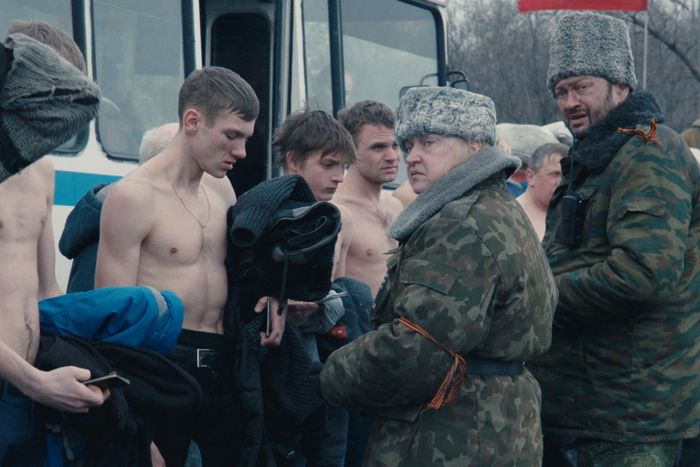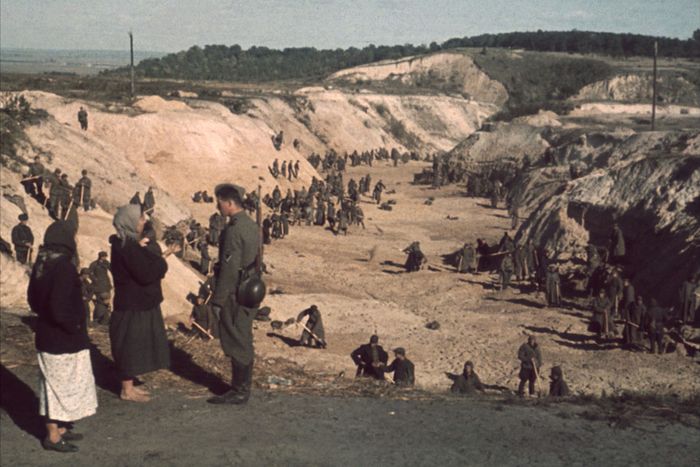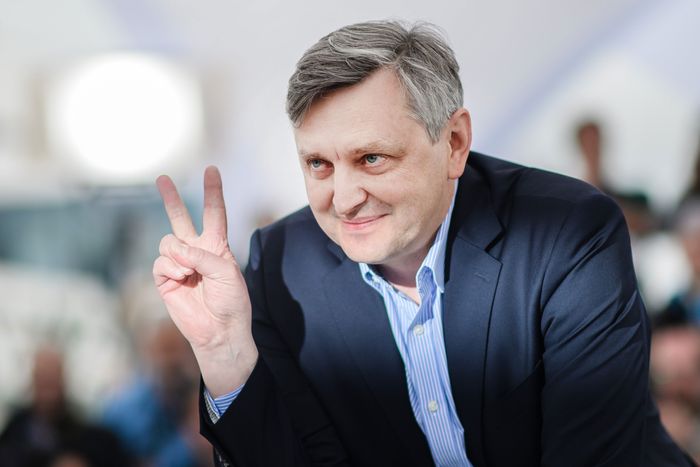
The great and prolific Ukrainian director Sergei Loznitsa has been a mainstay on the international film-festival and art-house circuit for some years, but he is now a man of the moment in somewhat unexpected ways. He was recently expelled from the Ukrainian Film Academy after his refusal to support a total ban on Russian films and filmmakers. Ironically, the ban came right after Loznitsa himself resigned from the European Film Academy for its initially weak response to the Russian invasion of Ukraine. All this occurred just as two of Loznitsa’s films were heading toward U.S. release.
The first, which opened last week, is his devastating documentary Babi Yar. Context, which uses stunning archival footage of the Nazi invasion of Kyiv during WWII to depict the events leading up to the mass murder of Ukraine’s Jews. The second, opening this week, is Donbass, Loznitsa’s surreal portrait of the wartorn Russian-occupied territories of Ukraine, which won a Best Director award at Cannes. For years, Loznitsa has switched between narrative and documentary, though the two forms directly influence one another. (Donbass is a narrative film, for example, but Loznitsa re-creates scenes based on actual events.) The director was originally trained as a scientist, and one can see the influence of that discipline on his films. When making a documentary out of archival footage, he tells me, he goes in with specific ideas about what the film should be then allows the footage to change those ideas.
To go with the two new films, the IFC Center will screen two earlier Loznitsa works: Maidan, his immersive 2014 documentary about the protests that brought down the Russian-allied government of Ukraine, and A Gentle Creature, a Kafkaesque 2017 drama about a rural Russian woman’s attempts to track down her imprisoned, mysteriously missing husband. I spoke with Loznitsa about his films, his recent controversies, the invasion of Ukraine, and an artist’s responsibility during times of war.
The past few weeks have been interesting for you. First, you wrote a letter to the European Film Academy condemning their weak response to Russia’s invasion of Ukraine. In response, they took a firmer stance and boycotted Russian films and filmmakers, which was a move you spoke out against. Then the Ukrainian Film Academy kicked you out. This all feels like something that could have happened in one of your films.
Absolutely, and I know exactly which film it is too. It’s In the Fog, in which the protagonist finds himself in the situation of being accused of something that he hasn’t actually done, but he has no way of proving his innocence. The reason why I felt that I wanted to leave the European Film Academy is because of their first statement, which they published a few days after the war began. I found it very weak, very timid. They even didn’t dare to call war a war, and I just couldn’t possibly agree with this.
This letter that I wrote to them, and the fact that I announced that I left the academy, made them completely change their position. After that, they reissued another statement, which was much clearer, and it was at that point that they actually began supporting the boycott of the Russian filmmakers. Those filmmakers who oppose the Russian regime and condemn the war should not be boycotted. I also find the idea of “boycotting” Tchaikovsky, Rachmaninoff, or Dostoevsky to be absurd.
At the same time, I was absolutely shocked by the decision made by the Ukrainian Film Academy, which without even talking to me, without discussing the situation with me, just made this decision to get rid of me, to cancel me as a Ukrainian filmmaker, which is impossible by definition. These actions are akin to the actions of Stalin’s regime, when all the dissidents, the people who dared to express any opinion which was contrary to the opinion of the state, were just destroyed.
But even in Soviet times, I don’t recall an instance when a filmmaker was actually expelled from the Union of Soviet Filmmakers. Of course, we do remember what happened with Boris Pasternak, who was expelled from the Union of Soviet Writers for writing Doctor Zhivago, so in a way we can say that the actions of the Ukrainian Film Academy can be compared to the actions of the Soviet Writers Union. At the same time, I’m convinced that this decision of the Ukrainian Film Academy is definitely not supported by the president of Ukraine, by the government of Ukraine, or by a substantial part of Ukrainian society. Despite the fact that Soviet heritage keeps popping up, and we have these instances of Soviet behavior and Soviet mentality coming back to the surface, I still believe that the majority of Ukrainian society remains free and Ukraine remains a free country.
I was struck by the viciousness of the language of the Ukrainian Film Academy. It was interesting to see them use the word “cosmopolitan” to describe you. I know in English that word has a very loaded connotation, having often been used in anti-Semitic contexts. Does it read that way over there as well?
Yeah. It is very possible. I can imagine that those people who were writing this statement and using these words just wanted to get their revenge for the film Babi Yar. Context, to which they reacted very strongly.
What was their reaction to the film?
There was a lot of criticism of the film — not specifically from the Ukrainian Film Academy but from individual filmmakers, journalists, historians, etc., who claimed that the film accuses the Ukrainians of collaboration with the Nazis. However, if you wish to know the Ukrainian Film Academy’s opinion, it would be much more appropriate to ask for their comment directly. I’m only communicating my opinion and my point of view.
How had your relationship with the Ukrainian Film Academy been before this most recent incident?
In 2018, my film Donbass was awarded the Best Scriptwriter Award, Best Director Award, and the Best Film Award by the Ukrainian Film Academy. My previous fiction film, A Gentle Creature, received the Best Director Award from the Ukrainian Film Academy. I would say that the relationship in previous years was professional.
Babi Yar. Context is brutal in showing the Nazi occupation of Ukraine and the atrocities committed, but it does indeed also show how ordinary people worked with the Nazis in these situations. It’s interesting that you pointedly called the film “context,” and now it’s being released in a very different context during this war. Some people I’m sure will be disturbed by what the film shows and interpret it the wrong way, not just in Ukraine but elsewhere. Does that worry you at all?
Of course, when I was making the film, I did not expect that the release in the United States would coincide with the war. I started working on this topic ten years ago, in 2012. Throughout this period, I was doing research and collecting material also for the fiction film that I’m going to make. It would be wrong to look at contemporary Ukraine through the prism of the events that are depicted in the film because these events happened 80 years ago. The Ukraine that is shown in the film Babi Yar. Context is very different from the country that exists at the moment. It’s two different Ukraines, two different countries, and it’s two very different wars. The Second World War was fought between two totalitarian regimes, between Nazi Germany and the Soviet Union, and the war that we are dealing with now is a war between a totalitarian regime and a free and independent country, which is fighting to defend its freedom and its independence. This is why also the consequences and the ways these two wars were and are fought are very different.
It’s interesting that back then the U.S. and the U.K. fought together with the Soviet Union in order to defeat one totalitarian regime. And at the moment, the U.S. and the U.K. are trying to fight together on the side of Ukraine in order to defeat the second remaining totalitarian regime, which used to be called the Soviet Union and which is now called Russia.
Does an artist’s responsibility change during times of war?
No, of course not. The role of an artist is always to understand, to reflect upon events that are happening or the state that society finds itself in. For example, as a result of the tragedy in Guernica, Picasso painted his painting Guernica, a fantastic and credible work of art which reflects the horror of what happened. This is the duty of an artist. An artist should do what he can and what he has to do.
How familiar were you with the events of Babi Yar growing up?
I grew up not far from the actual Babi Yar. So even as a child, I came across some material evidence of this tragedy — bits of bones, some remains — but I knew very little about the actual story of what happened. I learned about it gradually step by step, but I only found out the truth of what happened there when I read the novel by Anatoly Kuznetsov entitled Babi Yar. I was tremendously shocked by this story. At the time, I wasn’t even thinking of becoming a filmmaker, but apparently this impression lived in me ever since, and the need to tell the story has lived on.
Donbass premiered several years ago, but it’s coming out now in the U.S. And it’s not just tremendously timely but also makes an interesting companion piece to Babi Yar, even though it’s not a documentary. It shows us how resonant the memory of World War II is and the way that memory has been weaponized. You see the one separatist soldier yelling at the German journalists about what the Nazis did and the use of the word fascist in Russian-occupied territories to describe the other side.
That scene with the German journalist, I didn’t make it up. It happened for real, and the dialogue was exactly how it happened in real life. The story was told to me by a Ukrainian photographer who accompanied the German journalist, and in fact, this very Ukrainian photographer plays the part of the photographer in the film. So it’s based on documentary evidence. All those clichés, which were branded and created and consolidated by Soviet propaganda, are very much alive and very actively employed today.
I’ve always been intrigued by how so many of your documentaries use crowds. In a film like Maidan or your earlier film The Event, about the coup against Gorbachev, you present the crowd as almost its own protagonist. The conventional wisdom around documentary filmmaking might be to find a story or to find a character and follow that through to help keep the viewer’s interest. But you seem to take the opposite point of view. You focus on the crowd and on the multiplicity of faces in the crowd. I’m intrigued how you go about structuring your films because this seems to go against many of the rules of documentary filmmaking.
I don’t break the existing rules; I create new rules. In order to describe the processes that I want to describe, I don’t need a protagonist. In fact, introducing a protagonist would restrict my possibilities and would limit the narrative that I want to create because I’m interested in large-scale events — the events that afflict society as a whole. So I need to develop a new type of dramaturgy, a new type of structure and narrative. And I also need to invent new tools in order to keep the spectator’s attention. So what I do in my films depicting large masses of people, crowds, from episode to episode, I develop a certain thought, a certain idea, and I can say that this very idea becomes the protagonist of the film.
I recently rewatched your film Blockade, about the siege of Leningrad during World War II, which actually has a similar structure to Babi Yar. Both films even end with hangings. How do you go about structuring these films? You said you like to use an idea as the protagonist. Does that idea come from the footage as you research it, or does the idea come before and you then go and try to find the footage?
Well, it happens simultaneously, in a way. Of course, I already have an idea, a preconception, before I start working with the material. But then at the same time, I get ideas from the footage as I research it. If we compare Blockade and Babi Yar. Context — on the one hand, yes, you can say that there are similarities, but the structures of the films are different. In Blockade, I show the gradual destruction and death of a city up to the point of culmination, when we see a huge pit with dead bodies being thrown into it. So this moment with the corpses in this huge mass grave, that is where the story, the actual narrative, ends. The episodes that come after that are my interpretation. It’s a statement, in which I show my attitude, my commentary. So we have the narrative, we have the description of the destruction, and then we have my commentary, which gives a particular meaning to the events that you witness.
But in Babi Yar. Context, the actual end of the narrative occurs precisely halfway through the film. The actual massacre in Babi Yar is shown right in of the middle of film, so this is where the narrative ends. The second half of the film, you are presented with points of view, with the commentary about what happened. And then in the very center, in the very heart of this whole construction, as a pillar, as a foundation — the focal point of the whole film — is the text by Vasily Grossman, which actually tells you exactly what happened, that the entire Jewish population was killed. It was only after I came across Grossman’s text that I actually knew how to construct the whole narrative. And yes, those films, Babi Yar. Context and Blockade, they end with a scene of mass execution, which is of course absolutely shocking. It’s shocking to think that, even 75 years ago, it was still possible. So Babi Yar. Context is a kind of variation on and development of the dramaturgy of the film Blockade.
Was there any footage that you hesitated about using in Babi Yar?
Well, yes, of course there were scenes which were absolutely graphic, with graphic violence, and shocking. And yes, I decided not to use this.
I’ve noticed that your films are often focused on ceremony and ritual, which also ties in to the interest in crowds — even in your narrative films, like the wedding we see toward the end of Donbass. Is there something in ceremonies and rituals that you feel reveals something about us as humans?
Our entire lives are structured as a chain of various rituals. Even when we meet each other and shake hands, this is a ritual. Rituals tell us about ourselves, what we are. And in Donbass, it was very important to show this wedding ritual because it’s a parody. What happens is that the ritual is being destroyed from within. The theatricality of this ritual is being exposed, and also the nature of the ritual is being destroyed. All of life becomes grotesque, and the rituals that are part of this life also become grotesque. Again, this whole episode happened in real life, and it’s based on documentary material.




